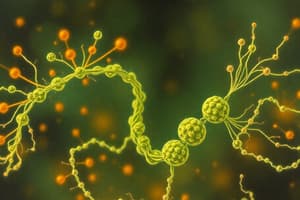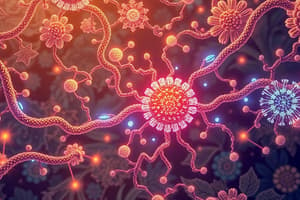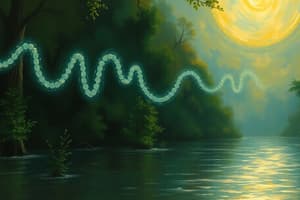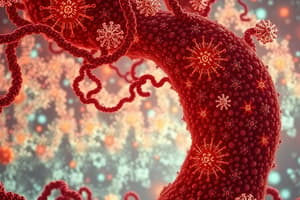Podcast
Questions and Answers
What is the branching structure of glycogen predominantly linked by?
What is the branching structure of glycogen predominantly linked by?
- α-(1,6) (correct)
- α-(1,2)
- α-(1,4)
- β-(1,6)
Which organ uses glycogen primarily to regulate blood glucose levels for the entire body?
Which organ uses glycogen primarily to regulate blood glucose levels for the entire body?
- Pancreas
- Skeletal Muscle
- Liver (correct)
- Brain
What molecule is required for the activation of glucose-1 phosphate before it can be integrated into glycogen?
What molecule is required for the activation of glucose-1 phosphate before it can be integrated into glycogen?
- ADP
- NADH
- ATP
- UDP (correct)
Which product is generated during the oxidative phase of the Pentose Phosphate Pathway?
Which product is generated during the oxidative phase of the Pentose Phosphate Pathway?
What kind of reactions occur in the non-oxidative phase of the Pentose Phosphate Pathway?
What kind of reactions occur in the non-oxidative phase of the Pentose Phosphate Pathway?
What is the role of glycogenin in glycogen structure?
What is the role of glycogenin in glycogen structure?
How many moles of free glucose can be obtained from the branching site during glycogen degradation?
How many moles of free glucose can be obtained from the branching site during glycogen degradation?
What is the primary function of ribose 5-phosphate produced in the non-oxidative reactions of the Pentose Phosphate Pathway?
What is the primary function of ribose 5-phosphate produced in the non-oxidative reactions of the Pentose Phosphate Pathway?
How many protons are pumped by one molecule of NADH in the electron transport chain?
How many protons are pumped by one molecule of NADH in the electron transport chain?
What is the function of the Glycerol 3-phosphate shuttle?
What is the function of the Glycerol 3-phosphate shuttle?
In glycolysis, how many ATP molecules are gained from one molecule of glucose?
In glycolysis, how many ATP molecules are gained from one molecule of glucose?
What is the total potential ATP yield from one mole of glucose, including glycolysis, TCA cycle, and oxidative phosphorylation?
What is the total potential ATP yield from one mole of glucose, including glycolysis, TCA cycle, and oxidative phosphorylation?
Which of the following compounds can provide glucose to the blood?
Which of the following compounds can provide glucose to the blood?
Which enzyme is involved in the conversion of pyruvate to acetyl-CoA?
Which enzyme is involved in the conversion of pyruvate to acetyl-CoA?
Which shuttle transfers cytoplasmic NADH to the mitochondria while forming FADH2?
Which shuttle transfers cytoplasmic NADH to the mitochondria while forming FADH2?
What is the role of phosphofructokinase (PFK-1) in glycolysis?
What is the role of phosphofructokinase (PFK-1) in glycolysis?
What is produced during gluconeogenesis from pyruvate?
What is produced during gluconeogenesis from pyruvate?
Which process involves the conversion of glucose to glucose 6-phosphate?
Which process involves the conversion of glucose to glucose 6-phosphate?
What is the definition of bioenergetics?
What is the definition of bioenergetics?
What characterizes a reaction with a negative ΔG value?
What characterizes a reaction with a negative ΔG value?
Which method is NOT a way to produce ATP?
Which method is NOT a way to produce ATP?
Which compound is an electron carrier in ATP synthesis?
Which compound is an electron carrier in ATP synthesis?
What is the primary function of glycolysis?
What is the primary function of glycolysis?
During the TCA cycle, what is the main product produced from pyruvate?
During the TCA cycle, what is the main product produced from pyruvate?
Which of the following describes a function of the electron transport chain?
Which of the following describes a function of the electron transport chain?
What occurs during the 'investment' stage of glycolysis?
What occurs during the 'investment' stage of glycolysis?
In glycolysis, how many ATP molecules are produced in total from one molecule of glucose?
In glycolysis, how many ATP molecules are produced in total from one molecule of glucose?
Which of the following is a byproduct of fermentation when oxygen is absent?
Which of the following is a byproduct of fermentation when oxygen is absent?
How is glucose primarily processed once inside the cell?
How is glucose primarily processed once inside the cell?
What role does the TCA cycle serve besides ATP production?
What role does the TCA cycle serve besides ATP production?
What happens to the electrons during the electron transport chain?
What happens to the electrons during the electron transport chain?
Which statement about ATP production is true?
Which statement about ATP production is true?
Flashcards
Bioenergetics
Bioenergetics
The study of energy transfer and utilization in biological systems.
Free Energy Change (ΔG)
Free Energy Change (ΔG)
The energy change that occurs during a chemical reaction.
Exergonic
Exergonic
A reaction that releases energy, ΔG is negative.
Endergonic
Endergonic
Signup and view all the flashcards
ATP (Adenosine Triphosphate)
ATP (Adenosine Triphosphate)
Signup and view all the flashcards
Substrate-Level Phosphorylation
Substrate-Level Phosphorylation
Signup and view all the flashcards
Oxidative Phosphorylation
Oxidative Phosphorylation
Signup and view all the flashcards
Glycolysis
Glycolysis
Signup and view all the flashcards
Gluconeogenesis
Gluconeogenesis
Signup and view all the flashcards
Pentose Phosphate Pathway
Pentose Phosphate Pathway
Signup and view all the flashcards
Glycogenolysis
Glycogenolysis
Signup and view all the flashcards
Glycogenesis
Glycogenesis
Signup and view all the flashcards
Citric Acid Cycle (TCA Cycle)
Citric Acid Cycle (TCA Cycle)
Signup and view all the flashcards
Electron Transport Chain (ETC)
Electron Transport Chain (ETC)
Signup and view all the flashcards
Chemiosmosis
Chemiosmosis
Signup and view all the flashcards
What is the Electron Transport Chain?
What is the Electron Transport Chain?
Signup and view all the flashcards
How do NADH and FADH2 contribute to ATP synthesis?
How do NADH and FADH2 contribute to ATP synthesis?
Signup and view all the flashcards
How many ATP are produced by the ETC per NADH and FADH2?
How many ATP are produced by the ETC per NADH and FADH2?
Signup and view all the flashcards
What is the total ATP yield from glucose oxidation?
What is the total ATP yield from glucose oxidation?
Signup and view all the flashcards
What is gluconeogenesis?
What is gluconeogenesis?
Signup and view all the flashcards
What is glycogen?
What is glycogen?
Signup and view all the flashcards
Describe the importance of glucose 6-phosphate.
Describe the importance of glucose 6-phosphate.
Signup and view all the flashcards
What does the Pentose Phosphate Pathway do?
What does the Pentose Phosphate Pathway do?
Signup and view all the flashcards
What is the Malate-Aspartate Shuttle?
What is the Malate-Aspartate Shuttle?
Signup and view all the flashcards
What is the Glycerol 3-phosphate Shuttle?
What is the Glycerol 3-phosphate Shuttle?
Signup and view all the flashcards
How is glycogen structured?
How is glycogen structured?
Signup and view all the flashcards
What is the role of glycogenin in glycogen metabolism?
What is the role of glycogenin in glycogen metabolism?
Signup and view all the flashcards
Where is glycogen stored in skeletal muscle?
Where is glycogen stored in skeletal muscle?
Signup and view all the flashcards
Where is glycogen stored in the liver?
Where is glycogen stored in the liver?
Signup and view all the flashcards
How is glucose 1-P incorporated into glycogen?
How is glucose 1-P incorporated into glycogen?
Signup and view all the flashcards
How is glycogen broken down?
How is glycogen broken down?
Signup and view all the flashcards
How is free glucose produced from glycogen breakdown?
How is free glucose produced from glycogen breakdown?
Signup and view all the flashcards
Study Notes
Bioenergetics
- Bioenergetics is the transfer and utilization of energy in biological systems
- Bioenergetics predicts if a process is possible, while kinetics measures the reaction rate
- Enzymes cannot initiate a reaction on their own. They only speed up reactions
- Enzymes help molecules move to their transition state
- A reaction is spontaneous if the change in free energy (ΔG) is negative
- Exergonic reactions release energy (ΔG is negative)
- Endergonic reactions require energy (ΔG is positive)
- Enzymes don't change ΔG
- Coupling: Combining a favorable reaction with an unfavorable reaction to make the overall reaction favorable
- ATP is a high energy molecule that provides energy for various cellular processes
ATP Production
- Substrate-level phosphorylation: ATP is directly formed during a metabolic reaction
- Oxidative phosphorylation: ATP is formed through the electron transport chain and chemiosmosis
Carbohydrate Metabolism
- Glucose is the primary source of energy for the body.
- Glycolysis: Glucose is broken down into two pyruvate molecules, producing ATP and NADH.
- Glycogenolysis: The breakdown of glycogen into glucose.
- Glycogenesis: The synthesis of glycogen from glucose
- Gluconeogenesis: The synthesis of glucose from non-carbohydrate sources.
- Pentose Phosphate Pathway: A pathway that produces NADPH and ribose-5-phosphate.
- TCA Cycle (Citric Acid Cycle): A cycle that breaks down Acetyl-CoA, producing ATP, NADH, and FADH2.
- Oxidative Phosphorylation and Electron Transport Chain (ETC): This process uses electrons from NADH and FADH2 to generate a proton gradient, which powers ATP synthesis.
TCA Cycle
- The cycle's main function is to harvest high-energy electrons from carbon fuels.
- The cycle captures electrons as NADH and FADH2, used in ATP production.
- The cycle also provides precursors for synthesizing various biomolecules
- Pyruvate is transported into mitochondria to convert to Acetyl CoA before entering the cycle.
Transfer of Cytoplasmic NADH to Mitochondria
- NADH cannot directly enter the mitochondria
- Two shuttles exist to transport NADH from the cytoplasm:
- Malate-Aspartate Shuttle
- Glycerol 3-Phosphate Shuttle.
- These shuttles generate FADH2 in the mitochondria.
Glycolysis
- Glycolysis is the breakdown of glucose to pyruvate
- Glycolysis generates ATP and NADH through substrate-level phosphorylation
- Glycolysis produces various compounds for further metabolic pathways
- Glycolysis is regulated by various steps that limit the rate of the reaction
Pentose Phosphate Pathway
- The Pentose Phosphate Pathway (Oxidative) creates NADPH and Ribose 5-Phosphate.
- Ribose 5-phosphate is used in nucleotide synthesis
- The pathway branches in two directions
- Non-oxidative reactions (reversible): produces glycolysis intermediates
- Oxidative reactions (irreversible) produces NADPH
Hormonal Regulation of Glycolysis
- Insulin generally increases glucose uptake and glycolysis. In other words, it triggers glycolysis.
- Glucagon generally inhibits glucose uptake and glycolysis. In other words, it inhibits glycolysis.
Studying That Suits You
Use AI to generate personalized quizzes and flashcards to suit your learning preferences.




